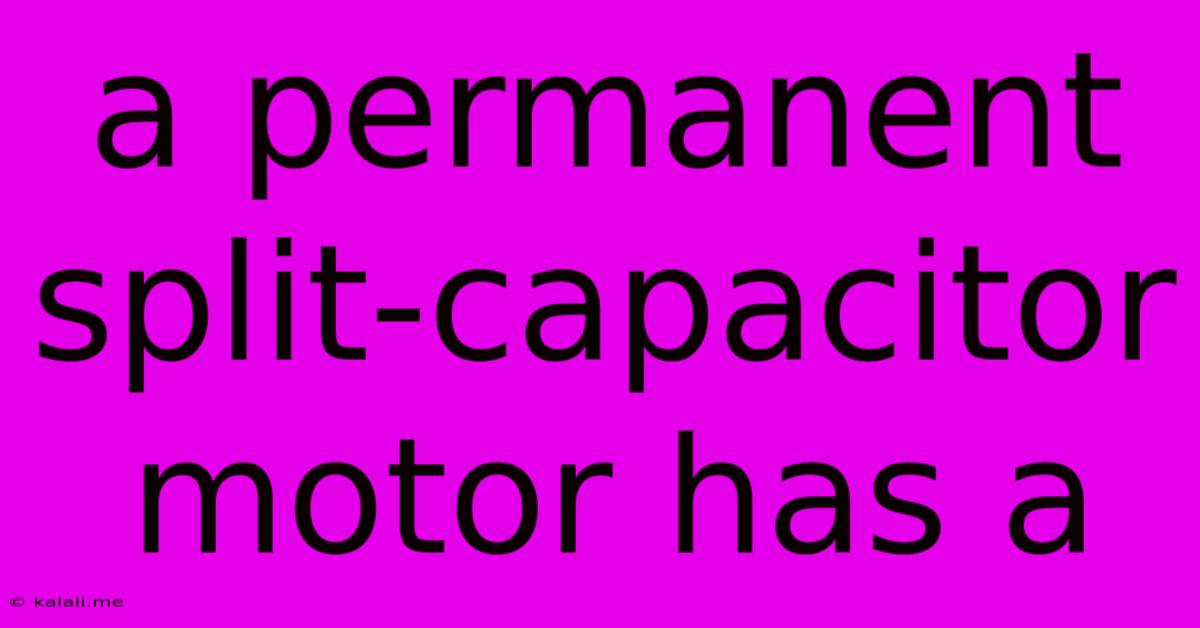A Permanent Split-capacitor Motor Has A
Kalali
Jun 12, 2025 · 3 min read

Table of Contents
A Permanent Split-Capacitor Motor Has a… Surprisingly Simple Design!
A permanent split-capacitor (PSC) motor is a type of single-phase AC induction motor known for its simplicity, efficiency, and relatively low cost. Unlike other single-phase motors, the PSC motor doesn't require a complicated starting mechanism – its design makes it self-starting. But what exactly does a permanent split-capacitor motor have that allows for this straightforward operation? The answer lies in its capacitor and unique winding configuration.
This article will delve into the key components and characteristics of a PSC motor, explaining how its design enables its self-starting capabilities and making it a popular choice for various applications. We'll explore the role of the capacitor, the motor's starting and running characteristics, and common applications where you'll find this type of motor in action.
The Heart of the Matter: The Capacitor and Winding Arrangement
The defining feature of a PSC motor is its permanent capacitor connected in series with the auxiliary winding. This capacitor is always in the circuit, both during starting and running. This is in contrast to other capacitor-start motors that disconnect the capacitor once the motor reaches a certain speed. This permanent connection provides a phase shift between the main and auxiliary windings, creating a rotating magnetic field necessary for self-starting.
The motor itself consists of two windings:
- Main Winding: This is a high-resistance winding connected directly to the power supply.
- Auxiliary Winding: This winding, typically with a higher number of turns and lower resistance than the main winding, is connected in series with the capacitor. The capacitor introduces a phase difference between the currents in the main and auxiliary windings.
This phase difference, caused by the capacitor's impedance, generates a rotating magnetic field that initiates the motor's rotation. This rotating field interacts with the rotor's squirrel cage to produce torque, allowing the motor to self-start and continue running.
Starting and Running Characteristics: A Smooth Operator
PSC motors are known for their smooth starting and relatively quiet operation. The constant presence of the capacitor provides a continuous phase shift, leading to smoother torque generation compared to capacitor-start motors. While they don't produce as much starting torque as capacitor-start motors, their starting torque is usually sufficient for most applications.
The running characteristics of a PSC motor are also noteworthy. The permanent capacitor, while optimized for both starting and running, might not be perfectly ideal for both conditions simultaneously. This usually results in slightly lower efficiency at full speed compared to other motor types. However, the overall simplicity and cost-effectiveness often outweigh this slight drawback.
Common Applications: Where You'll Find PSC Motors
Due to their reliable self-starting capability, simplicity, and relatively low cost, PSC motors find widespread application in numerous devices. Some common examples include:
- Fans: Whether ceiling fans, ventilation fans, or small desk fans, PSC motors are a popular choice for their quiet operation.
- Blowers: Small blowers and air movers often utilize the PSC motor for its simplicity and efficient starting.
- Small pumps: Certain types of small pumps, like those used in water features or aquarium filtration, often employ PSC motors.
- Household appliances: You might find them in various small household appliances, such as food processors or blenders, where smooth starting is desired.
In Conclusion: A Simple Yet Effective Design
The permanent split-capacitor motor has a simple yet ingenious design that allows for self-starting without the need for complicated starting switches or relays. The permanent capacitor's role in creating a rotating magnetic field is key to its functionality. While not always the most powerful or efficient motor type, its simplicity, cost-effectiveness, and smooth operation make it a prevalent choice for a wide range of applications requiring a relatively small and easily controlled motor. The absence of a complex starting mechanism contributes to increased reliability and lower maintenance requirements, further solidifying its position in many household and industrial settings.
Latest Posts
Latest Posts
-
Distance Of A Penalty Kick Soccer
Jun 13, 2025
-
Earth Is Divided Into How Many Time Zones
Jun 13, 2025
-
What Are The First 5 Multiples Of 9
Jun 13, 2025
-
Singly Linked List Vs Doubly Linked List
Jun 13, 2025
-
Queen Mary University London Acceptance Rate
Jun 13, 2025
Related Post
Thank you for visiting our website which covers about A Permanent Split-capacitor Motor Has A . We hope the information provided has been useful to you. Feel free to contact us if you have any questions or need further assistance. See you next time and don't miss to bookmark.